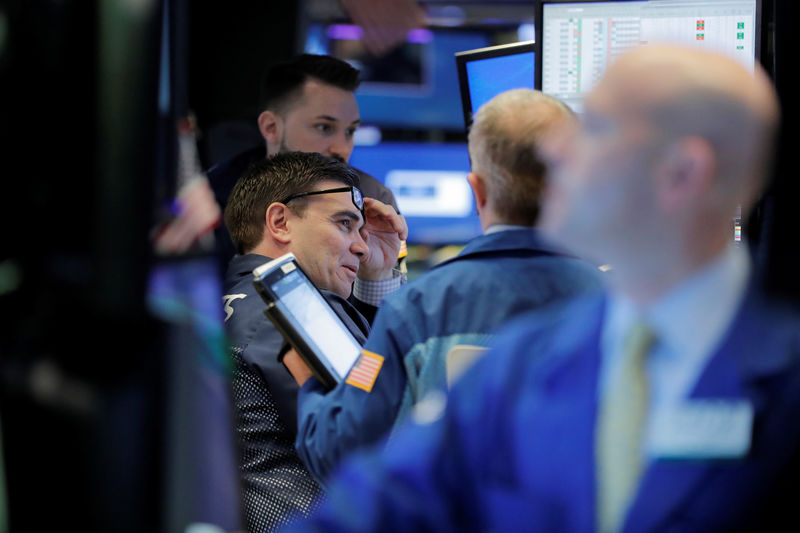Investing.com - Here are the top five things you need to know in financial markets on Thursday, April 12:
1. Stocks on edge over Syria tensions
Tension between the U.S. and Russia over Syria continued to keep stocks on edge on Thursday. The threat of imminent U.S. military action in response to a suspected chemical attack in eastern Syria rattled investors as U.S. President Trump taunted Russia with the possibility of direct conflict.
Nerves sent the Dow 200 points lower in the prior session and worries spread to Asian markets on Thursday. China’s Shanghai Composite closed 0.4% lower while Japan’s Nikkei ended the day with losses of 0.2%.
European shares showed caution on Thursday with most major indices trading slightly lower.
U.S. futures managed slight gains after trading near the unchanged mark in earlier trading on Thursday. At 5:54AM ET (9:54GMT), the blue-chip Dow futures rebounded 26 points, or 0.11%, S&P 500 futures advanced 5 points, or 0.19%, while the Nasdaq 100 futures climbed 16 points, or 0.24%.
2. Oil hovers near 3-year high ahead of OPEC report
Escalating geopolitical risks in the Middle East boosted oil prices overnight, but speculation over supply disruptions in the energy-rich region seemed to wane in early morning trade with crude trading around the unchanged mark amid concerns over rising U.S. stockpiles.
Investors will look a monthly OPEC monthly report to assess whether the oil-cartel stuck to agreed production curbs. Revision to oil demand growth and supply is also expected to garner attention after OPEC warned of rising non-OPEC production, led by the United States.
In its most recent report released in March, OPEC said non-OPEC producers would boost supply by 1.66 million barrels per day in 2018.
U.S. crude oil futures inched up 0.06% to $66.86 at 5:56AM ET (9:56GMT), while Brent oil was unchanged at $72.06.
The London barrel, the global benchmark outside the U.S., hit an intraday high of $72.48 on Thursday, its highest level since 2014.
3. Jobless claims, trade data and Fed in focus
Even as market participants keep an eye on geopolitical tension, attention will also focus on Thursday’s economic calendar with jobless claims, trade data and a speech by Minneapolis Federal Reserve Bank President Neel Kashkari on tap.
The Labor Department will release its weekly count of the number of individuals who filed for unemployment insurance at 8:30AM ET (12:30GMT) Thursday, accompanied by export and import prices.
On the monetary policy front, Kashkari, one of the most dovish Fed policymakers, will participate in a moderated Q&A at 5:00PM ET (21:00GMT). The appearance comes after Wednesday’s publication of the minutes from the Fed’s last policy decision which showed that policymakers remained confident of continued economic growth and appeared more optimistic on inflation hitting the Fed’s 2% target.
Fed fund futures continue to price in June as the most likely time for the U.S. central bank to once again hike rates, according to Investing.com’s Fed Rate Monitor Tool.
4. Tesla becomes the most shorted stock
There’s a dark cloud looming over shares of Tesla Inc (NASDAQ:TSLA) as Factset reported that more than 25% of Tesla’s available stock was sold short. The dollar amount of shares shorted on Tesla rose 28% in the last month to $10.7 billion to become the biggest short on Wall Street, according to CNBC, citing an update from S3 Partners.
The report came after Goldman Sachs cut its price target on stock to $195 from $205 on a likely capital raise this year and concerns over the company’s ability to meet its production targets.
Tesla's "sustainable production rate at present is likely below 2,000 Model 3s," around 1,400 a week, the Goldman Sachs said in the note.
That is well below Tesla's second-quarter forecast to produce 5,000 Model 3s a week.
The downbeat note on Tesla comes amid a Reuters report that the company is targeting November 2019 as the start of production for its Model Y sport utility vehicle, with production in China to begin two years later.
5. Zinc hits 4-month low amid broad metals selloff
Zinc sank to a four-month low on Thursday amid a broad selloff in metals as traders blamed fears of weak demand in China. A seasonal pickup in China's construction activity that usually comes in April and May has been off to a slow start, according to market participants cited by Reuters.
At 5:57AM ET (9:57GMT), zinc futures slid 3.7% to $3,112.25 a metric ton, its lowest level since December. In other metals trading, lead was down around 2.4%, nickel fell 1.6%, aluminum traded down 1.7%, while copper lost 1.8%.
